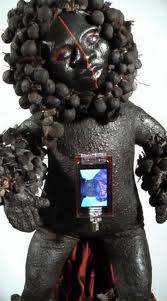presents
Passage
installation, sculpture, and video by Karen Seneferu
photography by Ron Moultrie Saunders
opening January 29th, 5-8
exhibition on view
January 29-March 11, 2011
|
 |
|
 |
|
Krowswork is pleased to present PASSAGE, which showcases video and video sculptures by Karen Seneferu and photography by Ron Moultrie Saunders. The work of each of these two artists portrays a unique vision of the body as both a force of form and as a means by which to transcend form and truly journey toward the more ineffable spirit realm. At the same time, the notion of passage also points toward a literal part of their African American heritage, and each investigates with care and keen understanding what is to be learned by a direct remembering and re-creation of that history.
Seneferu presents three life-sized "Techno-Kisi" figures, sculptures modeled after Nkisi spirit objects of the Kongo kingdom in Southwestern Africa. In their original form Nkisi figures are covered in nails, with a mirror at their bellies to reflect the faces of those who come to them for healing. In Seneferu's version the figures are covered in organic materials that serve as charms, and at the Techno-Kisi's center, instead of a mirror, is a video monitor, reflecting the "mirror and mystery of the community's intention." For Seneferu these sculptures manifest an "Afrifuturistic" aesthetic, providing a curative intersection between the natural, the technological, and the spiritual. For the presentation at Krowswork, which she calls Crossroad, Seneferu will create a ritualized "womb-like" installation into which visitors may enter and experience the Techno-Kisis' powerful techno-healing firsthand. This installation will be complemented by a docu-art video that describes the process of making the Techno-Kisis and demonstrates their purpose in context.
Saunders's dynamic photograms from his series "Someday I will be free" generate a taut tension between the personal and formal. Photograms are made using a cameraless technique in which the objects are exposed directly onto light-sensitive paper, a process made famous by the Surrealist photographer Man Ray. In these works Saunders taps directly into the emotions of the objects he is using, including his own head, body, and hands, layering this imagery with the light forms of objects from nature in a way that evokes a poetic narrative. For Saunders the photogram allows him to get to the heart of the subject by relying on the "magical light" from within, rather than objectifying it through a lens. In several works he calls Middle Passage, he has imagined the bodies of slaves thrown overboard into the Atlantic Ocean and the reality of a body encountering the vastness of the sea is made palpable in them. In other works, his figure melds with the veins of a leaf or bands of light, producing two-dimension images that feel sculptural and ever alive.
|
|